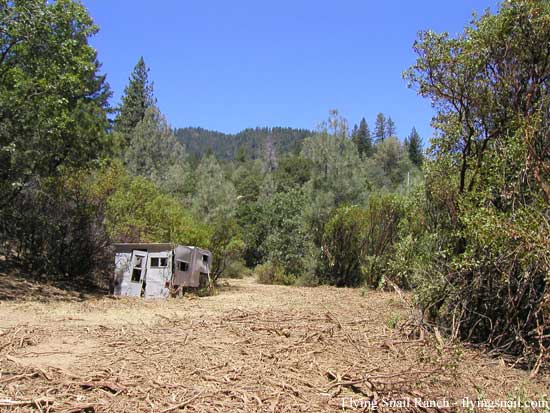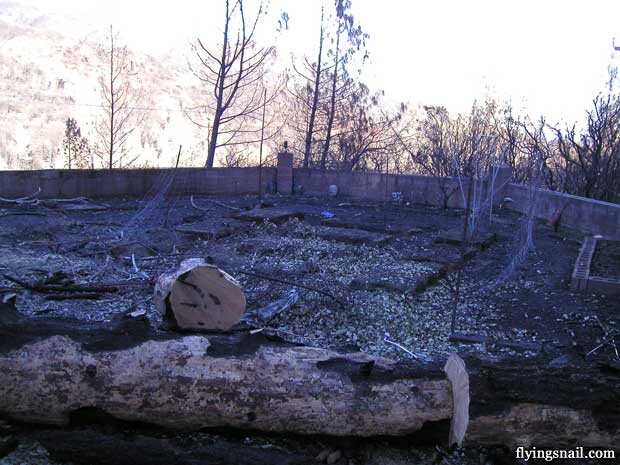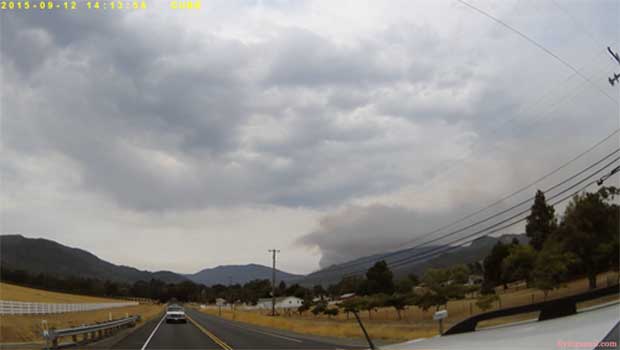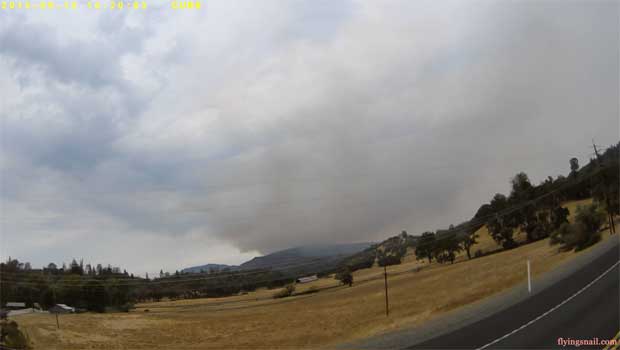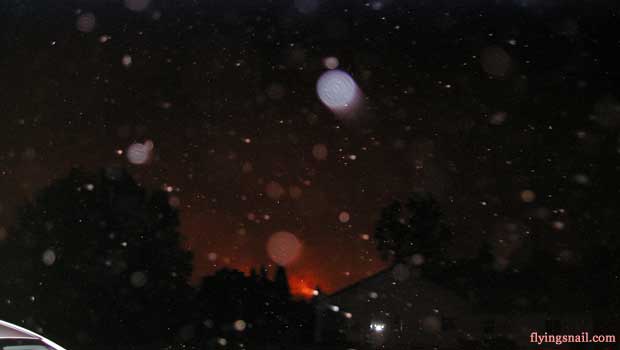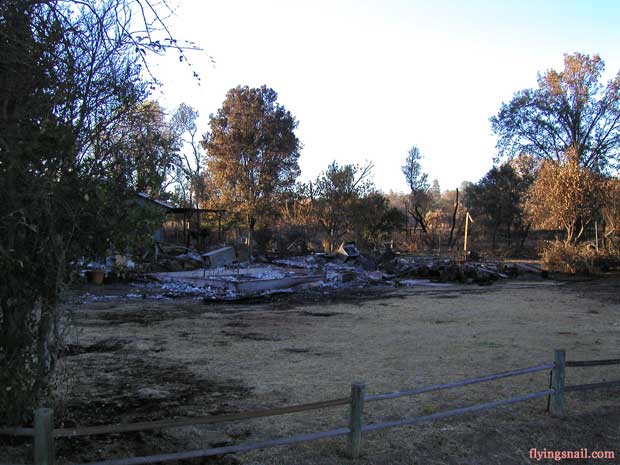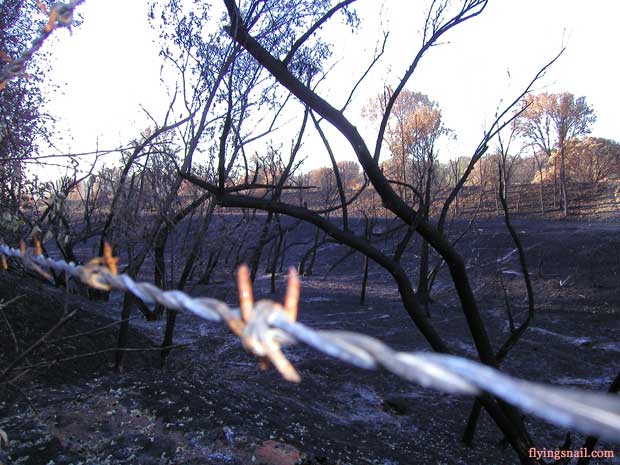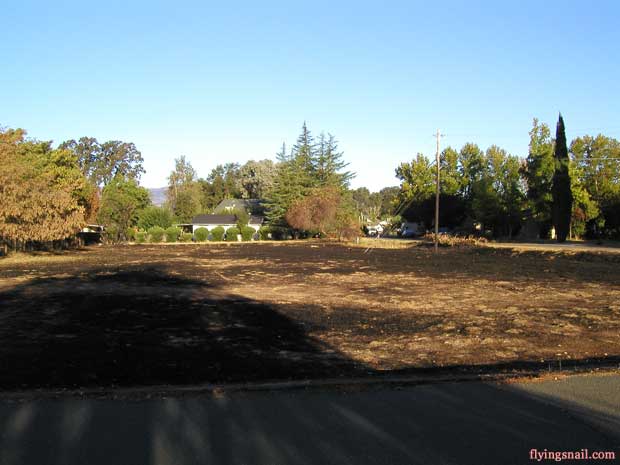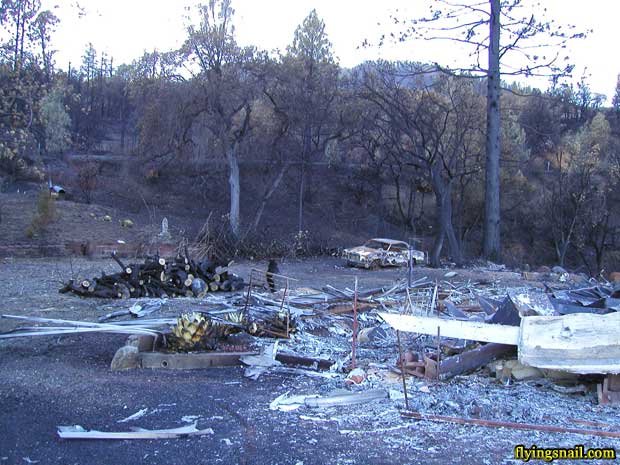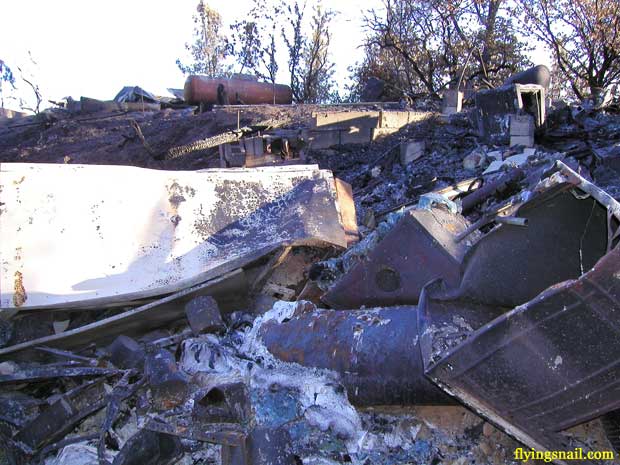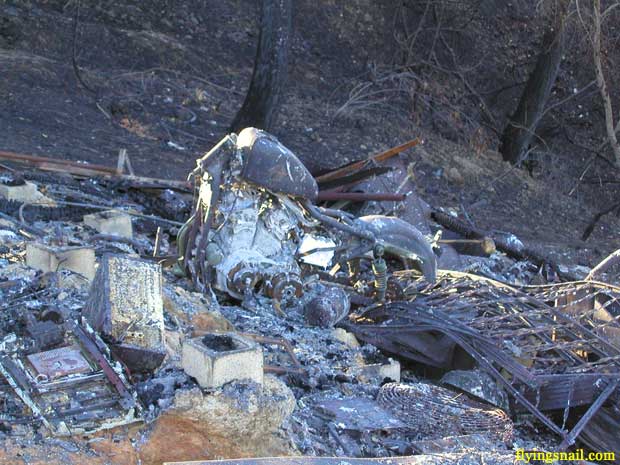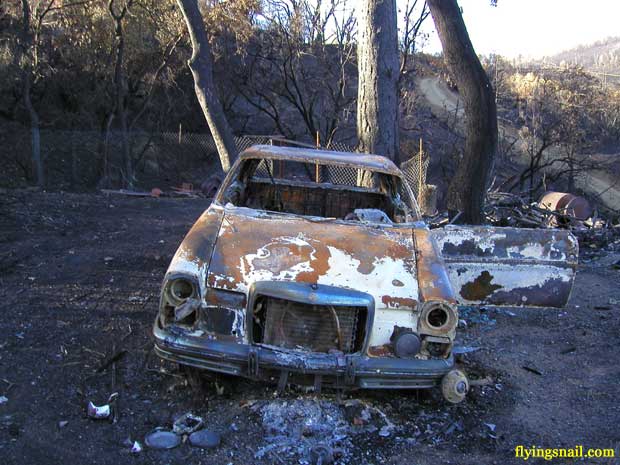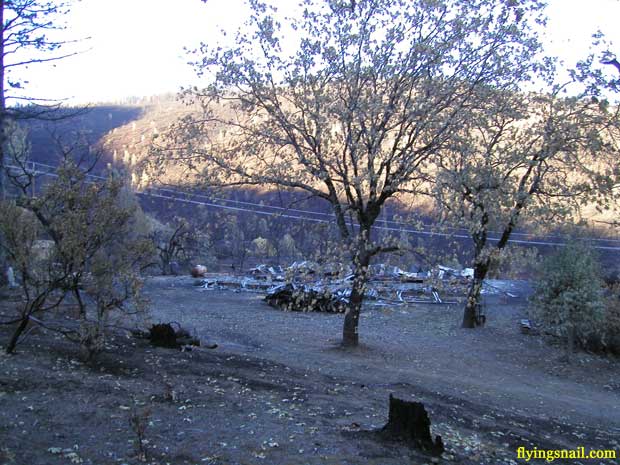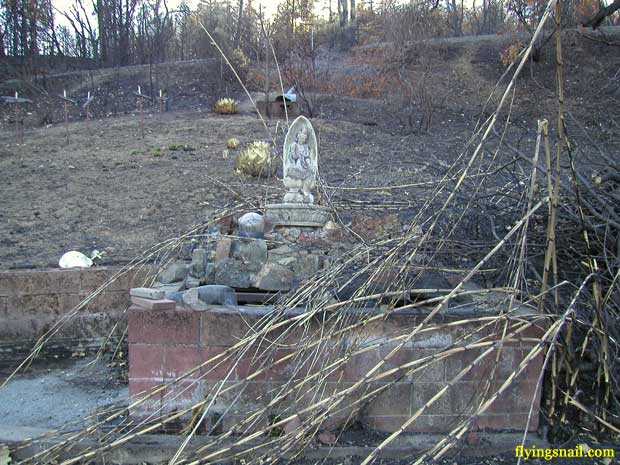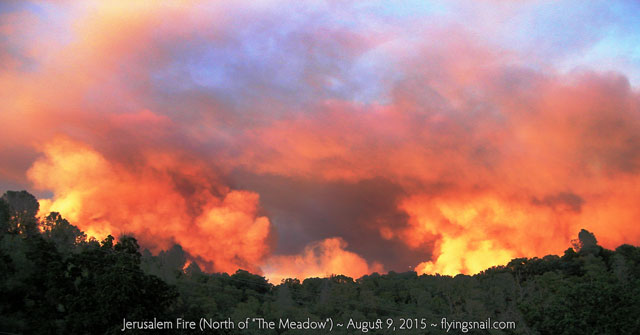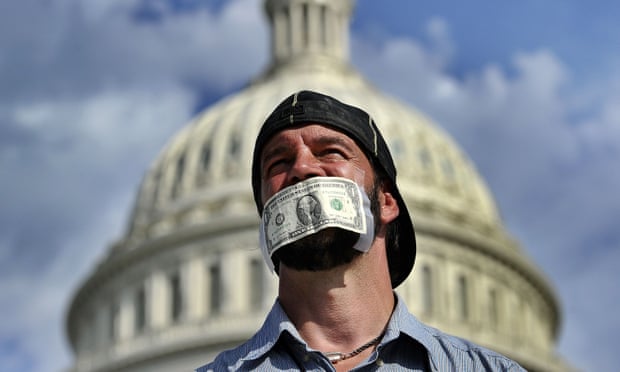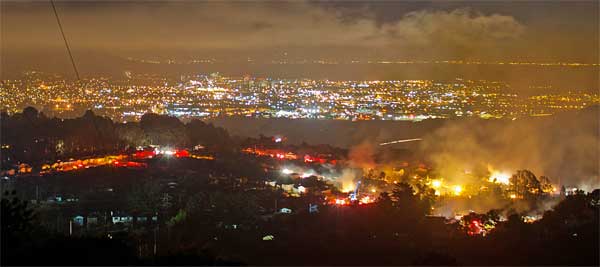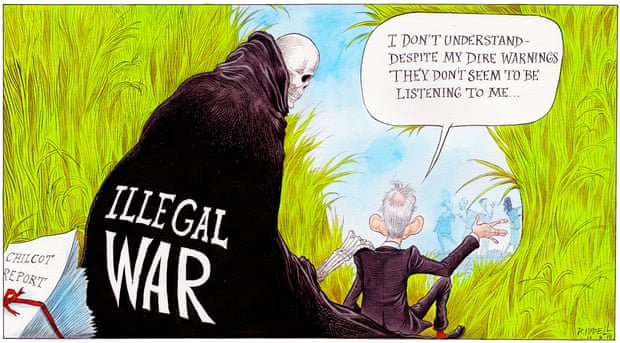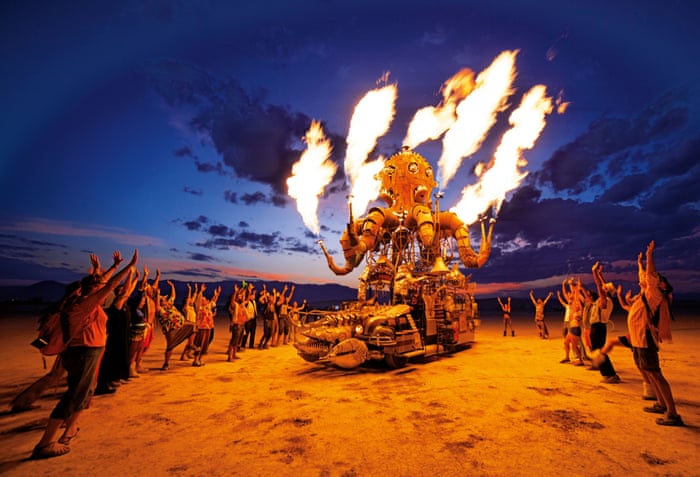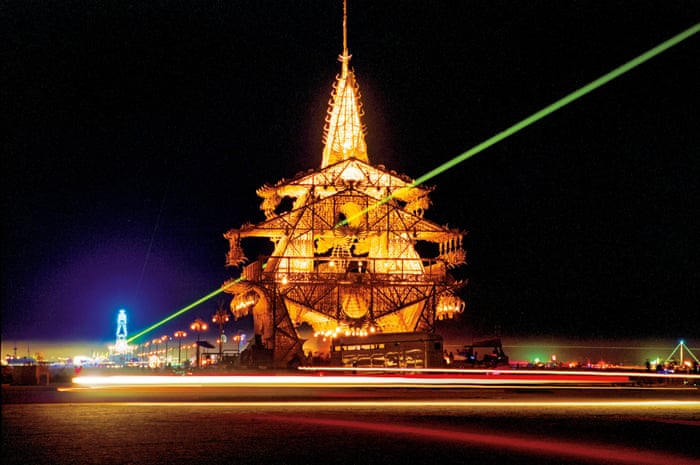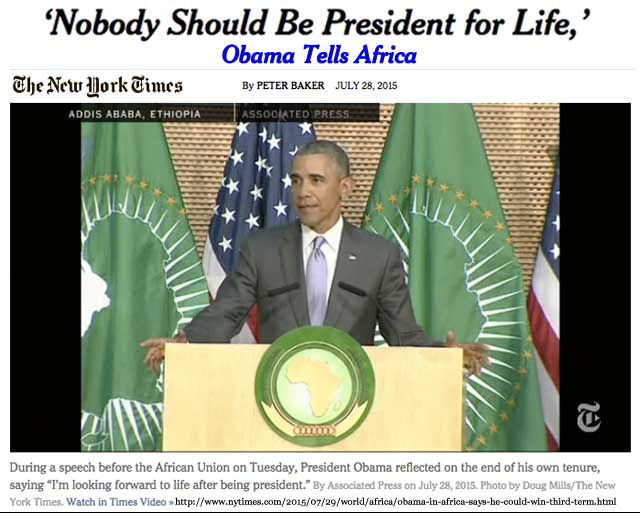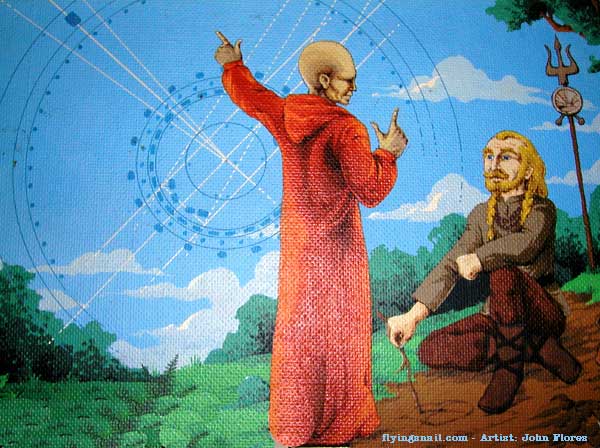Valley Fire
Valley Fire Incident Information
[Click to continue viewing Valley Fire photographs and story]
Imelda May, It's Good To Be Alive from prano bailey-bond, https://vimeo.com/97103979Check back here for related news.
Past:
Dahbud's old place ~ Flying Snail Ranch ~@~ 2007 Fire Watch collectionPresent:
Past:
[Click to view Seismic Shed Construction ~ Seismic Log ~ ARPSN]Present:
Present:
Past:
Present:
Past:
The Beginning
Saturday Morning Chores
Backyard, Eastern Ridge ~ With 300'/91m waterfall (white water) drop into pool at bottom (old photo).We were doing chores at "The Mountain" (our small ranch) when we noticed emergency vehicles going by and a helicopter, followed by a plane (fire, water bomber), fly over. Normally, this type of activity would suggest a vehicle accident has occurred somewhere 'up the road'.
We discover a fire is headed towards the ranch and a mandatory evacuation is issued at 15:47 PM (local time), Saturday, September 12, 2015. (fwiw) There are no animals at the ranch in danger's way.
When we leave "The Mountain" there was no smoke plume visible. About a mile down the road I looked in the rearview mirror and start filming:
Beginning of Valley Fire
16:50 PM ~ Fire is now in ranch backyard at top of the Eastern ridge.
17:00 PM ~ Mandatory evacuation has now been extended 6 miles below our (ranch) front gate.
We are okay and now at "The Meadow," (other home, 5 miles from ranch) where ash is coming down. This concerns us because ash embers are starting other fires within several miles of the fire origin.
The fire is now traveling very fast, generating its own weather (fierce wind), and creating small fire tornados, which rip across dry grass fields (pastures) at great speed, spreading the fire rapidly.
18:00 PM ~ Fire is in backyard of "The Meadow" and headed toward our house.
Note: What looks like snowflakes are burning embers and ash falling from the sky.
Photograph taken from "The Meadow" 2nd story deck, through dining room, glass sliding door.18:10 PM ~ Mandatory evacuation for "The Meadow," is being reported by neighbors.
A few houses down from "The Meadow" (waiting in line ~ top of car visible at lower left photo).18:20 PM ~ Sitting in line of cars waiting to get out gate. Fire on both sides of us.
In car headed for 1st gate. Fire is on both sides of us, about 2 city blocks away, moving quickly.19:30 PM ~ Took an hour to go one mile to get out 1st gate
20:15 PM ~ Clearlake Walmart parking lot with other evacuees.
21:00 PM ~ Clearlake Senior Center for night and slept in car.
September 13, 2015 ~ Off to Napa, to stay with friends. Both of our homes appear to be gone.
September 15, 2015 ~ See Internet video indicating "The Mountain" is gone (burned flat).
September 18, 2015 ~ 07:00 AM ~ See Internet video showing "The Meadow" still standing.
September 20, 2015 ~ See report indicating "The Mountain" may have survived.
September 21, 2015 ~ 18:00 PM ~ Return to "The Meadow." No eMail (sigh).
September 21, 2015 ~ No telephone, TV, eMail, Internet (sigh) and not allowed to visit ranch to find out status.
September 22, 2015 ~ Neighbors not happy about fire warning, etc. ~ Still no telephone, TV, eMail, Internet (sigh) and still not allowed to visit ranch to find out status.
September 23, 2015 ~ Still no telephone, TV, eMail, Internet (sigh) and still not allowed to visit ranch to find out status. ~ Telephone, TV, eMail, Internet restored 15:31 PM.
Follow up
287 walking steps East of "The Meadow"
311 walking steps SouthEast of "The Meadow" (backyard)
87 walking steps South of "The Meadow" (backyard)
87 walking steps South of "The Meadow" (backyard)September 24, 2015 ~ 10:10 AM ~ Update: The Mountain" is gone and I am still prohibited from entering the area.
September 25, 2015 ~ 06:30 AM ~ Update: Working on eMail catch-up and still prohibited from entering "The Mountain," which has burned to the ground according to CDF.
September 26, 2015 ~ 04:00 AM ~ Update: We will be allowed to visit "The Mountain" after 17:00 PM today; pictures later... == Thanks for the heads-up Kent.
Fire on the Mountain from Mark Messina ~ https://vimeo.com/8930155September 26, 2015 ~ 20:00 PM ~ Update: Aftermath of Valley Fire on "The Mountain".
Remembering previous fires
Jerusalem Fire ~ North of "The Meadow" ~ August 9, 2015
Jerusalem Fire ~ North of 'The Meadow' ~ 201508.09 ~ Click for CDF report ~ Photo taken from front deckFire on the "The Mountain" 2005
Fire watch 2007 ~ Photo taken from front gate at ranch
Brooks & Dunn "Hillbilly Deluxe" from HQ Productions ~ https://vimeo.com/44002637
The man whispered, "God, speak to me" and a meadowlark sang. But the man did not hear. So the man yelled "God, speak to me" and the thunder rolled across the sky. But the man did not listen. The man looked around and said, "God let me see you" and a star shined brightly. But the man did not notice. And the man shouted, "God show me a miracle" and a life was born. But the man did not know. So the man cried out in despair, "Touch me God, and let me know you are there" Whereupon God reached down and touched the man. But the man brushed the butterfly away and walked on.
Don't miss out on a blessing because
it isn't packaged the way you expect.
Paul Krassner ~ The Realist, Writer, Comic, Investigative Satirist
Roasting with Robin
By Paul KrassnerThe first time I met Robin Williams was in 1976 at the first annual Comedy Competition in San Francisco. He was sweating profusely, his hairy chest and arms showing, and he wore a brown cowboy hat. I was one of the judges. Although I voted for Williams, he came in second.
I forget the winner’s name, but I recall that the lights went off in the middle of his act, so he took advantage of the accident, and in the darkness he whispered loudly, “Okay, now, when the lights go back on, everybody shout out, ‘Surprise! Surprise!’” The audience laughed and applauded that ad lib.
Robin’s disappointment was palpable, but his stardom was inevitable. Our paths continued to cross backstage at benefits where we both performed. He was also a reader of The Realist. In 1988, the word got around that I was going to undergo surgery, and he sent me a generous unsolicited check to help.
In 1998, Anita Hoffman, Abbie’s widow, dying from cancer, decided to take her life on December 27, so as not to spoil Christmas for family and friends who were visiting and bringing all kinds of food. Her appetite was ravenous, and her humor was dark. After devouring a pastrami sandwich, she remarked, “I better brush my teeth, I don’t want to get gum pockets.”
She was staying at a house in San Francisco owned by actress Wynona Rider, whose godfather was Timothy Leary. He had been Anita’s role model during the final months of his life. “You couldn’t choose how and when and with whom you were born,” he said, “but you can take charge of your own death.” And that’s exactly what she was now doing.
Robin Williams learned about Anita’s situation from his co-star in Good Will Hunting, Matt Damon, who had been told about it by his girlfriend, Wynona. Robin had never met Anita, but he called and offered to pay a visit, in keeping with his benign case of Patch Adams Syndrome. After all, if Patch could travel to Trinidad to entertain murderers who would be hanged three days later, why shouldn’t it be appropriate for Robin to make Anita laugh on Christmas day? She hesitated—“I’ve never really been a fan of his work,” she thought—but then invited him to visit….
And so it came to pass in 2014 that Robin Williams would also commit suicide. In the midst of mass mourning him, Rush Limbaugh explained that “Leftists are never happy.” And the anti-choice Lifenews claimed that Robin killed himself out of guilt over an abortion his girlfriend had in the 1970s.
The last time I saw him was in 1987 on a Saturday evening at the Hollywood Press Club, where we were both participants at a roast for Harlan Ellison, the prolific author of fantasy, science-fiction and speculative-fiction, his work including 1,700 short stories. He also had a reputation for angry ranting with literary style. My wife Nancy said, “He has a black belt in Mouth.”
The roast was supposedly a fundraiser for his defense in a frivolous libel lawsuit. Although the auditorium was filled at $25 a head, the plaintiff, Michael Fleischer, was suing Ellison for a million dollars. In a 1980 issue of Comics Journal, in a review of Fleischer’s comic-book-novel, Ellison called him “crazy” like H.P. Lovecraft and other renowned writers. Ironically, Harlan had intended it to be a compliment.
Screenwriter David Gerrold remarked, “The fact that Ellison is a self-made man relieves God of a great responsibility. I’ve been Harlan’s friend for six years. Of course, I’ve known him for eighteen years.”
The moderator of the roast, film critic Digby Diehl, read a telegram from Isaac Asimov, which concluded, “Kick him in the balls—signed, Frank Sinatra.” Onstage, Asimov’s fellow science-fiction writer Robert Silverberg announced that “Harlan Ellison is so short that he goes up on his girlfriend.” Robin and I were sitting next to each other, and we simultaneously crossed that joke off our imaginary lists.
There were short-jokes galore. Have a few free samples: “Short? I carry a life-sized portrait of Harlan in my wallet.” “Harlan’s parents were normal, but the milkman was a syphilitic dwarf.” And the producer of Twilight Zone, Phil de Guere, complained, “It took Harlan nine months before he figured out how to shoot himself in the foot at Twilight Zone and get canned. But of all the people I have worked with, Harlan is by far the shortest. Harlan doesn’t have a short fuse. He is a short fuse.”
My own short-joke was, “Actually, this isn’t a roast. It’s more like a microwave.” Robin said, “Harlan is a tall Paul Williams, a white Paul Simon.” I pointed out that “Harlan is on the right side of a lot of important fights. He’s fought against racism and sexism. That’s why this whole panel is white males.”
A roast by definition overflows with irreverence, insults, and raunchiness. Examples: “If it’s true that you are what you eat, Harlan would be a vagina.” Stan Lee of comic-book infamy said, “Harlan is a very difficult person to arouse. Ask any of his former wives.” And Robin contributed a metaphorical dick joke: “If you’re hung like a field mouse, don’t stand in the wind.”
I stated that “Harlan is an egomaniac partially because at the moment of sexual climax, he calls out his own name.” Robin shouted: “Was it good for me?” I responded, “Harlan has a typewriter with only two letters—M and E. And on it he has somehow managed to write 42 books as well as 300 of Steve Allen’s songs plus a few of Lyndon LaRouche’s speeches.”
Robert Psycho Block remembered when “Harlan was interested in re-writing other people’s work. He took me into a nearby drugstore and showed me how he had erased all the M’s off all the Murine bottles.” I observed that “Harlan has always refused to get involved with the drug world—as a user. However, he is a dealer. In fact, he was the connection for Kathy Evelyn Smith.”
A severe groan emanated from the audience, and I realized that I was treating a roaster as a roastee, not an uncommon practice. Robin Williams and Robert DeNiro had been with Smith and John Belushi on the night of Belushi’s death. “Oh, that’s a good one,” Robin said with understandable Sarcasm 101. “Listen,” I replied, “if she didn’t plea-bargain, you wouldn’t be here tonight.”
Moderator Digby Diehl proceeded to rub salt in Robin’s wound that I had unintentionally caused: “Robin Williams has been called the king of improv, and he has proven it tonight by interrupting everybody, stepping on their lines, doing schtick. He’s been about as annoying he can be.”
“I loved that review, though,” said Robin, referring to Diehl’s negative critique of Club Paradise.
Diehl: “I was hoping you hadn’t seen it, Robin. It’s said of you in Hollywood that you don’t read your scripts. Anyway, ladies and gentlemen, I’d like to bring you Robin Williams, fresh from Club Paradise, his biggest failure yet.”
Williams: “Thank you, Gary Franklin [the movie reviewer Diehl replaced]. What can you say about a man who’s a TV critic? A man who looks at a good film and letters it like a report card. Is that art? I think not. And I’d like to thank Harlan’s lawyer for proving, God, is there a reason for law? I think not. And I’d like to thank Mr. Krassner for all the Kathy Smith references. That’s some funny stuff.”
Robin confessed, “I really don’t know Harlan for shit,” then described his house. “ It’s like Notre Dame done by Sears. There’s Harlan, naked, playing in his toys with a beautiful shiksa goddess jumping up and down saying, ‘I like him. He’s smart.’” Robin morphed into a little boy in the bathroom. “I’m reading Bradbury, dad.” (Roaster Ray Bradbury chortled. Robin suppressed a fake sob.) “It’s just taken me so far down to be here. I wish I could cry but I don’t care.” (The audience applauded.)
“Well,” said Diehl, “it’s been basically a really hostile, ugly night, with a lot of lame jokes and sentimental drivel. But we still have the ritual forgiveness to look forward to.” He introduced Harlan Ellison, “a man with the milk of human kindness dripping from his fangs.”
“Ha, ha. Very funny, I’m sure,” Harlan reacted. “I had a friend once, but the wheels fell off. Zip friends. Dust is my friend. And what of these fuckers here? Robin Williams can’t even get a pair of pants that fits him.”
“There’s a reason for that, Harlan.”
“Yeah, sure. It was for you they made up the phrase, ‘Is it in yet?’ You wanna talk about that, Williams? I’ve got four words for you: Club Paradise and The Survivors.”
“Yeah, on a double bill with Man With a Dog [Ellison wrote the screenplay].”
Harlan continued to baste the roasters. As for me, he said, “I want to thank my old chum Krassner for being here tonight. I want to commend him on his restraint in the remarks he made. Or perhaps it was only caution on his part because I promised if he fucked around with me, I’d let on that he caught his herpes from Nancy Reagan.”
Digby Diehl concluded, “Harlan’s only fear is that he’ll get in a car accident and have to re-live this event. And in the true tradition of roasting, that tradition being to talk dirty and mention a big name, thank you all for coming. And join us next week when our guest roaster will be Mother Teresa.”
I blurted out, “I fucked her.”
The audience screamed, hooted, stomped. Robin jumped out of his chair and ran around in a circle. Then he said, “Gandhi is going, ‘Who is this man? He may not get through the gates of heaven for that line.’”
Harlan said, “Thank God Krassner got off one good one.”
I explained, “I guess I just fell into the insult mode.”
“Basically,” said Robert Silverberg, “the roast is a really ugly, repugnant, immature and childish art form. I hate it. And I will only do one if Harlan is the target.”
And on our way home, Nancy summed up the irony: “A compliment was originally perceived as an insult, and consequently we’ve had an evening of insults which were really compliments.”
Culture Shred: Rat Rod Rockabilly from John "G" Gotgart ~ https://vimeo.com/81549094
Brooks & Dunn "Hillbilly Deluxe" from HQ Productions ~ https://vimeo.com/44002637
Notes from ~@~
Remembering our dear friend: Robert Pruzan
September 12, 1946 ~ May 29, 1992
Dahbud Mensch ~ is SANITY the PLAYGROUND of the unIMAGINATIVE ?
"The United States government has the right to demand emails of anyone in the world from any email provider headquartered within US borders."
Department of Justice (DoJ) lawyers told a federal appeals court on Wednesday
wtc 7 explosion from ham der ~ https://vimeo.com/16923460
WYD AE911 Truth Ad from Popeye Theophilus Barrnumb ~ https://vimeo.com/70304745
Architects & Engineers: Solving the Mystery of WTC 7 from AE 9/11 Truth
https://vimeo.com/28023241This is AE911Truth's new 9/11 documentary on the mysterious destruction of World Trade Center Building #7, WTC 7 on 9/11/01. Join actor, Ed Asner and Architect Richard Gage, AIA and Architects and Engineers as they narrate an unfolding story that decimates the official account ("collapse due to normal office fires") of this 47 story high-rise which was destroyed on the afternoon of 9/11 in record time: top to bottom in under 7 seconds - and at free-fall acceleration for a third of its fall. Solving the Mystery of the Free-Fall collapse of WTC 7.
Dr Judy Wood from Andrew Johnson ~ https://vimeo.com/63810454On 11 Sept 2001, astounding events unfolded in the USA -- including the complete destruction of World Trade Centre Towers 1, 2 and 7. These events changed the world -- changed all our lives. Yet, it was years later that an official investigation was launched. All mainstream media sources generally take a view that those official investigations were adequate - and no one should have cause to seriously question them. However, the pictures show that WTC 1 (like WTC 2) did not "burn up", nor did it "slam down" -- it was turned into dust in mid air -- leaving almost nothing of the building itself.
Dr Judy Wood, a former Professor at Clemson University, USA, with degrees in Civil Engineering, Mechanical Engineering and Materials Engineering Science, will present rarely seen graphic evidence which proves what really happened to those enormous structures. Her detailed scientific study exposes a challenging conclusion which most people have never had a chance to see, hear and evaluate. Dr Wood is the only person to submit elements of her forensic study in a US Federal court case in 2007, news of which was censored.
911thology - WTC nuclear demolition Dimitri Khalezov 02 of 26 from DieHard911
https://vimeo.com/121979089/11 WTC nuclear demolition & the Soviet missile in the Pentagon. Dimitri Khalezov, a former officer of the Soviet nuclear intelligence, explains true mechanics of pulverisations of the Twin Towers & the WTC-7, as well as existence of a secret nuclear demolition scheme of the World Trade Center in New York & of the Sears Tower in Chicago. Detailed explanations about 'ground zero' name, 'Doomsday Plane', the Pentagon missile. Perfect answer for questions by the 'Architects and Engineers for 9/11 Truth'. Practically no question is left of the 9/11 mystery.
Face to Face with Dr. Niels Harrit from Victoria Indy TV ~ https://vimeo.com/20574556"There is no doubt that this building was taken down in a controlled demolition ... there is no way around this conclusion." States Dr. Niels Harrit referring to World Trade Center Building 7.
Dr. Niels Harrit (retired associate professor of chemistry) and his team at the University of Copenhagen published a paper in The Open Chemical Physics Journal and verified that red/grey particles of non-reacted nanothermite was found in the dust of the WTC buildings. This finding is irrevocable proof -- the veritable DNA -- that "Office Fires" and jet planes did not bring down the three buildings on that fateful day. 9/11 has been the prima facie excuse for incursions of the U.S. and NATO into foreign nations, the sole justification for suspension of our domestic civil liberties and the common denominator of "The War on Terror".
This interview traces Dr. Harrit's personal and professional journey into and through the events of 9/11 and beyond. ~ © 2011 Lazarus Productions
MAD AS HELL - The Music Video from JERM ~ https://vimeo.com/15066497
Undone Lullaby from dj schmolli ~ https://vimeo.com/110558373
Dahbud Mensch ~ is SANITY the PLAYGROUND of the unIMAGINATIVE ?
America's decline in wages can be
traced to the George W Bush eraWhat if a re-reading of the data reveals the Reagan and Clinton years actually boosted the wages of blue collar and middle income households?
A protester joins a demonstration in front of the US Capitol in Washington, DC, October 2013
urging Congress to pass the budget bill. Photograph: Jewel Samad/AFP/Getty ImagesPhillip Inman ~ Economics correspondent, 6 September 2015, theGuardian source
One of the statistical touchstones for left-leaning economists is the run of figures showing that US workers have suffered three decades of flat wages. There is no better way to illustrate how capitalism, marching to its own tune, fails most of America’s 160 million workers than wage data that hardly moves from year to year after inflation is taken into account.
Nobel prize winner Joseph Stiglitz and best-selling economist Thomas Piketty often characterise the 1980s and 1990s, as well as the 2000s until the financial crash, as periods of stellar growth that bypassed the average worker. This story of workers slaving, only for corporations to reap the benefits is allied to Piketty’s history of wealth accumulation, which puts a figure on the astounding riches in property and savings amassed by the most affluent 1% in recent years.
But what if a re-reading of the data reveals the Reagan and Clinton years actually boosted the wages of blue collar and middle income households? Would the broader argument that unfettered capitalism always drives down the proportion national income taken in wages be fatally undermined?
The answer can be found in the pages of a report for the Brookings Institute that looks for the first time at census data going back to the beginning of the 1980s and examines groups of workers and charts their progress as they age.
It is a study that might help us understand the rise of Donald Trump as a populist blue collar hero and, at the other extreme, the left-leaning Vermont senator Bernie Sanders in the upcoming presidential primaries. Not because ordinary workers found themselves stuck in a rut for 30 years when all around them enjoyed the party of the century.
The new data shows that many of them had much higher incomes to splash on homes and cars. Instead the anger comes from their gains being wiped out from the 2001 recession onwards. And the only response of George W Bush’s team and the Federal Reserve was to protect the rich with tax cuts and cheer workers with ultra low interest rates that, as we know, underpinned the sub-prime mortgage scandal.
Both Trump and Sanders appeal to people who blame the slide in their living standards over the last decade, at least in part, on a political elite that failed to understand their concerns.
Until recently, an examination of the labour market relied on the annual publication of average wages. That is how the story of flat wages for the many and super-returns for the few over such a long period has emerged. Each calculation of average wages is a snapshot of all the people in the workforce. Unfortunately, millions of people quit the labour market during the year and others join. It is not the same cohort, and not just at the outer margins.
Robert J Shapiro, a former economic adviser to Bill Clinton who now runs the Sonecon consultancy in Washington, grabbed the opportunity to look at the raw census data when the US statistical office published it a few years ago.
He tracked the median incomes of average households as they travelled through the decades, checking on the progress of men versus women, Hispanic people versus black and white people, college graduates and different age groups. The report presents us with a more nuanced picture of the workforce and how it has fared.
He found that the 1980s boom, which gained traction in the middle of the decade, boosted the wages of all but the oldest group of workers. So large, steady income gains characterised the average household whether they were headed by men or women, or by people with high school diplomas or college degrees, whatever their ethnicity.
As Shapiro said: “This evidence contradicts the narrative told by those who track the value of aggregate income from the 1970s to present the claim that most Americans have made little progress for decades.”
The momentum dissipated in the first Bush presidency between 1989 and 1993 and accelerated again in the Clinton years before running out of steam in the early 2000s
Then came the downturn. The second Bush era, under George W, was painful for almost all but twentysomething college graduates, who even survived the 2008 crash with barely a scratch, and was worst for those without a high school diploma. Shapiro says the least educated saw their incomes “devastated” after 2001.
“Across the three younger age-cohorts, the median income of households headed by people without high school diplomas fell an average of 1.9% per year as they aged through the 2002-2007 expansion; and over the entire period from 2002 to 2013, their median incomes fell by an average of 1.8% year as they aged,” the report says.
Between 2010 and 2013, households where the main earner had been aged 25 to 29 back in 1982 suffered even more if they quit education before going to high school. They lost 7.1% in income in each year as vast numbers either took a cut in pay, in hours or were made unemployed.
The rise and fall of the average workers’ wages documented in the report chimes with the business cycle and the trend in Europe, which followed a similar trajectory.
The average German worker made income gains through the same period before a deregulation of the labour market under the Social democrat Gerhard Schroeder brought about an effective freeze in wages from 2003.
In the UK, the chancellor at the time, Gordon Brown, reacted to the downturn by switching on the government spending taps. He introduced tax credits as an income top-up to offset the trend for flat or falling real wages. It was a policy that insulated British workers from a trend that clobbered Americans and to a lesser extent German workers.
Retelling the economic story of the 1980s, Shapiro says the US benefited from a mix of Reagan’s expansionary policies in defence and infrastructure and the collapse of commodity prices after the inflationary oil shocks of the 1970s.
George Bush senior was forced to cope with the borrowing hangover from the Reagan years before Clinton assumed the presidency.
It’s no surprise Shapiro is a cheerleader for the Clinton years, which he argues developed employment and productivity boosting policies that favoured women, minorities and low-income employees like no other time in recent history.
What happened after 2001 and Bush junior’s failure to protect workers from globalisation is something that the next president must address, he says. What he calls “the dark side of globalisation”, which was driven by China’s over-investment in export industries, sending oil prices soaring while still flooding world markets with cheap goods, is still with us.
Beijing’s shift away from export subsidies has sent oil prices dropping again, offering the west an opportunity, but unless government offer workers some insulation, the radical politics of Trump and Sanders will only gain ground.
In Conclusion
How come Bush/Cheney & Obama Administration politicians, who authorized a Patriot Act and spying on US citizens, can't protect US citizens from cyber attack ???
;-) Is it because they are actually conquering, space alien, clones left here to care for us as a new source of food; sometimes referred to as "the herd"? (-;
Remember, Nobody will protect you forever! ~ Nobody for President
Immigrants to the US should 'speak American' ~ Sarah Palin
Dahbud Mensch ~ is SANITY the PLAYGROUND of the unIMAGINATIVE ?
September 9, 2010 ~ San Bruno
View of PG&E initiated San Bruno fire on Sep. 9, 2010 at 11:31 pm PDT ~ WikipediaPG$E & PUC Executives Continue
to Get Away with Corporate Murder?Time For a Corporate Death Penalty?
Mercury News editorial:
Don't let PG&E dodge
San Bruno responsibilityMercury News Editorial, 07/21/2015 12:24:50 PM PDT, San Jose Mercury News Source
The Legislature has to emphatically block PG&E's obscene effort to take a tax deduction on the $1.6 billion fine it's paying for the utility's role in the San Bruno pipeline blast.
The California Public Utilities Commission made it clear when it issued the fine in April that shareholders should bear the brunt of it and that no tax deduction should be allowed. San Mateo Sen. Jerry Hill's SB 681 would specifically prevent PG&E from realizing a tax windfall from the penalty.
SB 681 is an urgency bill, taking effect immediately upon the governor's signature. It requires two-thirds support of the Legislature. The vote should be unanimous, but there are signs of a partisan divide.
That's incomprehensible to us. PG&E took money intended for gas pipeline improvements and instead spent it on executive bonuses and shareholder dividends. The result was death and destruction in San Bruno. Republicans should be as committed as Democrats to holding the company responsible.
Unfortunately, the Senate Finance and Governance Committee voted along party lines last week in sending the bill to the Appropriations Committee, which will take it up later this summer. Republicans could block passage.
In a letter to the Internal Revenue Service from PUC President Michael Picker and Commissioners Catherine Sandoval, Carla Peterman and Liane Randolph, the California State Board of Equalization and the California Franchise Tax Board, the PUC wrote:
"We fully intended and hope that any attempt by PG&E to deduct any of the costs of complying with the commission's final decision be clearly and decidedly disallowed on the basis of their punitive nature."
The PUC carefully structured the penalty so that ratepayers would absorb as little pain as possible. In fact, $400 million will go to PG&E customers as a one-time credit. Another $850 million will help pay for the pipeline improvements PG&E failed to make when it diverted funds to line various pockets instead.
It's not like PG&E can't afford the fine. Its first-quarter profit was $418 million, up more than 65 percent from the same period in 2014 and beating Wall Street projections. The company said that despite the fine, it expects earnings to range from $3.50 to $3.75 a share for the year, which would also top Wall Street expectations.
But PG&E is trying to exploit a technicality in tax law to avoid taking full responsibility.
It shows the cynicism of those corny commercials the utility is running to try to improve the company's image. As for retiring PG&E CEO Anthony Early's statement that "The lessons of San Bruno will never be forgotten and will continue to guide our work" -- he must have been smirking when he said it.
PG&E won't do the right thing on its own. The PUC finally tried to impose responsibility, but now it's up to the Legislature to pass Hill's SB 681 so that justice is done.
PG&E, corporate criminal
The utility likes to pretend it's a good corporate citizen – but the record shows otherwise.
By Savannah Blackwell, Article source
WHEN IRISH IMMIGRANTS arrived on San Francisco's shores during the first few decades of the past century, it wasn't easy for them to find decent, stable jobs. John Hanley, the president of the local firefighters union, likes to say that for many the only options were the police department, the fire department and Pacific Gas and Electric Co.
PG&E has played hard on its reputation from those days, using stories like Hanley's to push blue-collar workers to oppose public power. The company has spent millions on other public relations efforts: for years, PG&E representatives talked about all the widows and orphans who were living off company stock, and hyped the money the company gave to local charities.
But the image of PG&E as a fine, benevolent, and upstanding corporate citizen is long gone.
Today, with PG&E's stock in free fall, the small shareholders who had hoped to use the utility's stock as part of their retirement income are in trouble – while the same executives who drove the company into bankruptcy are earning multimillion-dollar bonuses.
The charitable contributions that once helped buy PG&E political protection have dried up.
And over the past few years, PG&E's most lasting legacy has become that of a corporate criminal.
Consider:
• In 1997 PG&E was tried and convicted in criminal court for endangering the lives and property of gold country residents by failing to trim tree branches near electrical wires frequently enough to prevent major fires. Evidence showed that PG&E executives had diverted tree-trimming money to fatten profits and salaries of top corporate executives.
• The story of the company's poisoning of community water supplies in Hinkley became a major Hollywood movie called Erin Brockovich, and a similar environmental disaster is still underway just south of San Francisco. Meanwhile, residents of the Bayview-Hunters Point district in San Francisco are suffering from alarmingly high rates of asthma and other illnesses that they link to PG&E's dirty power plant in the neighborhood (see "Poison Power," 1/28/98). In addition, the nearby Potrero power plant, which PG&E sold to Mirant Corp. in 1998, is scheduled for expansion.
• PG&E stole nearly $200,000 from San Francisco by illegally running its power lines to the Presidio, according to a 1995 lawsuit the city filed against the company. Indeed, PG&E's service to San Francisco residents is illegal, according to the terms of the 1913 Raker Act, which requires the city to operate a public power system. The company's monopoly has led to decades of structural corruption at City Hall (see "How PG&E Wires the City," page 26).
• In 1998 a major blackout hit the city – leaving nearly half a million San Francisco residents without electricity (see "Still in the Dark," 12/16/98). Officials determined that a failure to make a key backup safety check at a San Mateo substation caused the outage. For several years the company had been cutting back on maintenance staff to fatten profits.
• In 2001, after lobbying for the 1996 bill that deregulated part of the state's electricity industry, PG&E shuffled off more than $600 million in profits to its holding company, gave its top brass $50 million in bonuses and raises, and declared bankruptcy. Since spring 2001, rates have soared 40 percent and customer service for everything from hook-ups to billing problems has worsened (see "Feeling the Crunch," 9/4/02).
• Under its proposed plan to get out of bankruptcy, PG&E wants to free itself of the last vestiges of state regulation while at the same time making a very anti-free market demand: ratepayers must protect its shareholders and CEOs from any potential future losses (see "Competing Energy Visions," page 30).
• PG&E has a long record of harassing internal whistle-blowers and reporters who dare to take on the giant company.
When former presidential candidate Ralph Nader talked to reporters at an Oct. 8 forum at the Commonwealth Club of California, he slammed the company's business practices: "PG&E was caught up in the whole deregulation scam, which it helped frame and get through the [California] legislature unanimously. [It] promised that rates would be reduced by 2000. Instead, PG&E has been caught up in a wild gyration of transforming the electricity industry into a speculative commodity marked by secret deals and collusion, which is just now being exposed by government investigators and newspaper reporters. Nader was at the club to support fellow Green party candidate Peter Camejo in his bid for governor.
"I think on the philosophy of 'Three Strikes, You're Out,' there have been more than three strikes. [The company] should be subject to eminent domain and takeover by a public power entity to establish lower rates, cleaner energy, and the more focused efficiency we've learned to expect from the better-run public power districts in California."
Burning down the houses
In 1994 a disastrous wildfire struck the community of Rough and Ready in Nevada County, scorching 500 acres, destroying a dozen homes, burning a historic schoolhouse down to the ground, and running up $2 million in damages. Residents, some of whom lost everything they owned, literally had to run for their lives.
The local district attorney was livid: the fire was started by tree branches brushing against high-voltage PG&E lines – and for years California forestry officials had been telling the company to cut back those tree limbs. In 1997, D.A. Michael Ferguson, in an unusual move, took the corporation to criminal court, charging it with 746 counts of violating the state law requiring the utility to maintain safe clearance around power lines. Ferguson accused PG&E of a chronic and widespread pattern of negligence that resulted in the 1994 fire (see "Burning Secrets," 3/12/97, and "The People v. PG&E," 4/2/97).
PG&E brought in the big guns. The company hired former U.S. prosecutor Joseph Russoniello to defend its actions. But a quiet, determined assistant D.A. named Jenny Ross, who had practiced in San Francisco with Pillsbury Madison and Sutro, prevailed with the jury. The company was found guilty of 739 counts of criminal negligence and fined $2 million.
The evidence brought forward by the prosecutor was overwhelming. With the help of utility analyst Bill Marcus of Sacramento, Ross showed how PG&E had taken $80 million from ratepayers between 1987 to 1994 that was supposed to pay for tree trimming. Instead, the company used it to pad profits and ensure hefty salaries for CEOs at a time when it was trying to make up for losses incurred from the screwed-up construction of the Diablo Canyon nuclear power plant. PG&E had raked in more than $1 billion in profits the year prior to the fire.
Ross presented loads of documents (which PG&E fought fiercely to keep confidential) – including personal e-mails between staffers – in which it was clear PG&E's brass had made a fatal decision to save money by drastically cutting back on tree-trimming staff. PG&E's managers even mocked the forestry officials for their constant warnings of danger.
The California Public Utilities Commission, whose officials were angry PG&E had hoodwinked them during rate cases involving the tree-trimming money, took up the matter and fined the company $29 million in 1999.
Nevada County wasn't the only site of major fires caused by PG&E. In fact, California Department of Forestry officials told us in 1997 that PG&E's failure to trim overgrown trees had caused some 760 fires.
In 1997 a devastating fire in Los Gatos was caused by molten aluminum particles spewing from a PG&E power pole. Although PG&E was never charged with a crime, the company agreed to pay the full cost – $2.5 million – of the fire.
Poisoning the water
Not many utility companies have been the subject of major Hollywood films. But in 2000, director Steven Soderbergh released a blockbuster about the illnesses and deaths in Hinkley, a Mojave Desert town of 3,500, and how a rough-and-tumble law-firm clerk named Erin Brockovich forced the company into what was the largest class-action settlement of its time: $333 million.
The rampant sickness in the community was tied to exposure to chromium 6 prevalent in the groundwater. PG&E, which owned a natural-gas pumping station on about 20 acres near the town, never acknowledged direct responsibility for the illnesses. Runoff from the station, which also contained chromium 6, was stored in unlined wastewater ponds. The corporation knew the ponds were leaking into the water supply.
In Daly City, residents living in Midway Village, a 150-unit federally subsidized housing development, have for years suffered unexplained headaches and high rates of cancer, as well as skin disorders and neurological problems. They found out they were living amid toxic waste from lampblack (a kind of carbon) and coal tar in their yards and under the property directly next door, which PG&E owns as part of its Martin Service Center. The stuff had been there for at least 100 years – left behind by a gas manufacturing plant. Residents charged that PG&E had known for more than 15 years that residents were being exposed to dangerous carcinogens such as benzoapyrene and other petroleum-based cancer-causing toxins yet did nothing to warn residents or sufficiently clean up the mess. In 1980, state records showed, PG&E workers even complained to the U.S. Environmental Protection Agency about the problem, and some of the waste was removed.
Ten years later, the first set of residents sued PG&E. Eventually, 180 plaintiffs accused the company of endangering their health. In 1997, San Mateo County Superior Court Judge Joseph Bergeron dismissed the case, saying that residents hadn't proved a direct link between their illnesses and the chemicals in the soil. The residents appealed. In 2000 the state Court of Appeals upheld the superior court judge's findings and threw out the residents' suit. Now residents are focusing on trying to force state officials, who removed more contaminated soil in 2001, to compensate them for the costs of treating their illnesses and to pay to relocate them.
"From Bayview-Hunters Point to Midway Village and other communities, you see a pattern of PG&E putting corporate greed above the health of people impacted by their operations," Bradley Angel, director of Greenaction, an environmental justice group based in San Francisco, told us. Angel said it was only in the past few weeks that environmental and Native American activists, with the help of a bill authored by state assembly member Fred Keeley and signed by Gov. Gray Davis, succeeded in stopping PG&E's plans to send radioactive waste to Ward Valley. "We see a pattern of threats to community health as well as a pattern of environmental racism and injustice."
These are just a few examples of PG&E's blatant disregard for public health and safety. There are numerous others: For example, in 1997 Sonoma County settled a case against PG&E in which the district attorney alleged that the company's Geysers geothermal plant emitted hydrogen sulfide at levels higher than the law allowed (see "Another Step Forward," 3/19/97). That same year a Santa Clara jury awarded $30 million to the family of seven-year-old Cole Behr. The family claimed that Behr, who can barely walk and cannot speak, was born with brain damage because his mother, Cynthia, was exposed to carbon monoxide related to PG&E's gas service when the dangerous chemical infiltrated the heating system of a San Jose office building where she worked when she was pregnant.
Cheating the city
PG&E never should have delivered power to San Francisco. But even the terms under which it breaks the federal Raker Act are unfair. Since 1939, PG&E has paid San Francisco a pittance – 0.5 percent of its annual gross receipts on electricity sales – for the right to run its gas and electric lines across city property. San Francisco granted PG&E that deal under an agreement that supposedly lasts "in perpetuity" – a clause city attorneys, including Louise Renne, have used to staunch efforts to take the utility to court and get a better deal. The national average for so-called franchise fees is 4 percent.
But low fees weren't enough for the company – it tried to get away with paying nothing for a key part of its system. The Bay Guardian reported in 1994 that PG&E had illegally run its lines into the Presidio and never paid the city a dime in franchise fees for those lines (see "The Presidio Power Grab," 1/12/94).
After the story came out, Controller Ed Harrington undertook the first audit of the franchise fees and determined that PG&E owed $114,000 for delivering power to the Presidio over the years 1991 to 1993 and $18,218 for 1994 and 1995.
Former supervisor Angela Alioto forced then-city attorney Louise Renne to take PG&E to both state and federal court over the issue. In 1997, at the behest of Renne, the city settled the state case for a mere $132,494 (see "Settling for Less," 5/7/97, and "City Hall's Gift to PG&E," 7/16/97). The city had originally asked that all of the money the utility made while engaged in the unlawful business of using city property without the right to do so be returned to city coffers and that PG&E be fined $2,500 for each day broke the law. That would have been $53 million.
The federal case was decided in PG&E's favor in part due to mistakes Renne made in the case in 1996 (see "Presidio Power Outage," 1/1/97).
In addition PG&E successfully fought off the city's efforts to get the Presidio electricity contract, which would have brought in needed revenue and allowed for a significant expansion of the city's public system, which currently serves city agencies.
Thanks, PG&E
If you like higher electric rates, and you enjoyed the rolling blackouts of 2000, you can thank PG&E, which played a major role in bringing deregulation to California.
PG&E and the state's two other major private electric companies, Southern California Edison and San Diego Gas and Electric, were not the initial instigators of the push to deregulate the industry. That came from large commercial users and former Republican governor Pete Wilson. But soon the utilities became boosters and saw a way to rid themselves of the historic limits on their profits.
With San Diego state senator Steve Peace at the helm, PG&E and the other utilities succeeded in getting a sweetheart deal from the legislature. Spending some $4 million in lobbying efforts and $1 million on campaign contributions, the three companies got a bill that protected their profits and forced customers to foot the bill for more than $28 billion in money they lost building nuclear power plants – even though PG&E customers had already paid inflated rates to make up for Diablo Canyon for years (see "You Lose," 8/13/97).
PG&E was particularly effective at pushing the deregulation bill. Midway through the bill-making process, the company brought on Dan Richard, who had been representing independent power producers, to lobby for its interests instead. Richard didn't even tell former assembly member Diane Martinez, who was in charge of the legislation in the assembly, that he had changed jobs and had become a flack for PG&E, she told us in 1997.
The final bill was supposed to allow customers choice in the electricity market. But it required all customers in PG&E's service territory, whether they wanted to buy power from PG&E or not, to pay for PG&E's nuclear power plant costs. That prevented potential rivals from being able to offer cheaper deals and made a mockery of Peace's promise that ratepayers would get a choice (see "Guilty Parties," 2/14/01).
In 1998 consumer advocates Nader, Harvey Rosenfield, the Consumers Union, and the Utility Reform Network tried to overturn the part of A.B. 1890 that required customers to pay for the nukes. But PG&E and the other two utilities poured some $30 million – with PG&E accounting for more than half – into a rash of misleading ads, bought the support of key environmental and consumer groups, and defeated the measure at the November ballot (see "Buying the Bailout," 10/14/98).
Then, in 2001, reeling from the implosion of the deregulated energy market and the high cost of power from out-of-state utilities, PG&E demanded that someone else bail the company out of its troubles. PG&E declared its utility company bankrupt – after shipping over the previous nine months more than $600 million to its parent company and shielding other revenues from creditors (see "Missing in Action," 4/11/01)
PG&E's top executives, who had started this whole debacle, got raises and bonuses totaling $50 million.
Silencing critics
Although PG&E likes to insist it is a tolerant and responsible company, it has a long history of retaliating against any employee who blows the whistle on its irresponsible practices.
In the 1997 Nevada County fire case, one of the prosecution's star witnesses was Jim Sprecher, a PG&E engineer who had written a report concluding that the company was letting trees go untrimmed for too long and jeopardizing public safety. Instead of heeding Sprecher's concerns, the company demoted him, relegating him to an unimportant job and ostracizing him socially, he testified.
He also testified that the report mysteriously disappeared from his unlocked filing cabinet at work at some point between 1993 and late 1996, when he was contacted by Nevada County prosecutors (see "Vanishing Report," 5/21/97). The report's recommendation to increase spending on tree trimming was ignored by PG&E higher-ups.
At PG&E's April 1998 shareholders meeting, Neil Aiken, a shift foreperson at the Diablo Canyon nuclear power plant, stood up and told shareholders about safety problems that came from cost cutting at the plant. He told the audience he came forward only in desperation, because he had exhausted all possible routes of solving the problem within the company. He also released a report detailing the safety issues called "Going Critical" (see "Nuclear Leak," 4/22/98).
That year PG&E executives forced Aiken to undergo psychiatric evaluation. He was locked out of the plant and forced off his job after 24 years (see "Plugging the Leak," 11/18/98). The Project on Liberty and the Workplace took up his case, and the U.S. Department of Labor found PG&E guilty of retaliation in November 1999 (see "PG&E Fires Whistleblower," 4/5/00).
PG&E also has a history of blackballing reporters who challenge the utility. Energy writer J.A. Savage sued PG&E in 1988, charging that the company had gotten her fired from two jobs because she had once worked for an antinuclear group and had written for the Bay Guardian. She settled the suit for an undisclosed sum in 1995 after the state Court of Appeals found that her allegations had enough merit to go to trial (see "Reporter Beats PG&E," 11/8/95).
"PG&E wields considerable power over the press covering its activities," Judge Williams Newsom wrote in a 1993 appeals court opinion dealing with the question of whether PG&E should be able to blacklist reporters who work for the Bay Guardian. "In the case of a public utility enjoying such extensive monopolistic authority ... there is an important public interest in assuring the freedom of the press in reporting on matters lying within the exercise of its franchise."
PG&E has used its formidable power to undermine that constitutionally protected freedom. The haze of P.R. the company generates regarding its operations has proved effective in protecting the utility's empire – at the direct expense of the public's financial interests, safety, and health.
P.S. Sup. Chris Daly will hold a hearing at the Board of Supervisors' Public Works and Public Protection Committee about the impact of PG&E's 40 percent rate increase on the local economy and small businesses and the deterioration of the company's customer service Oct. 16, 10 a.m., City Hall, Legislative Chamber, 1 Dr. Carlton B. Goodlett Place, S.F. (415) 554-7970. E-mail Savannah Blackwell at savannah@sfbg.com.
Chilcot Report ~ Death wearing an ILLEGAL WAR cloak ~ and Tony Blair saying, "I
don't understand ~ Despite my dire warnings THEY don't seem to be listening to me.."
Chris Riddell ~ 16/08/2015 @ theGuardian
Who runs Hollywood?
Google has an anti semitic answer:
Blaze of glory: the flaming art of Burning Man ~~ in pictures
El Pulpo Mecanico, 2014, by Duane Flatmo and Jerry Kunkel
Photographs: NK GuyThe art of Burning Man: skeletons, temples and flaming Tetris
Besides pounding techno and swirling dust, the desert festival is home to a host of spectacular art installations. ~ [Click to view: Here are some of the best]
The Temple of Joy, 2002, by David Best and the Temple Crew Click to view show
American Uptown Funk from dj schmolli ~ https://vimeo.com/117399873
Imelda May, It's Good To Be Alive from prano bailey-bond, https://vimeo.com/97103979
Notes from ~@~
Carlin Step ~ DJ Steve Porter & Eli Wilkie ~ http://vimeo.com/21162532
The Great Bell Chant (The End of Suffering) ~ http://vimeo.com/6518109
One Day ~ Matisyahu ~ http://vimeo.com/11520225
Unsung Hero ~ Still Anonymous ~ http://vimeo.com/90853494
Rock Of Ages ~ DJ Schmolli / Video: Panos T ~ http://vimeo.com/44298418
Freedom of expression and freedom of speech aren't really important unless they're heard...It's hard for me to stay silent when I keep hearing that peace is only attainable through war. And there's nothing more scary than watching ignorance in action. So I dedicated this Emmy to all the people who feel compelled to speak out and not afraid to speak to power and won't shut up and refuse to be silenced. ~ Tom Smothers
Nobody for President ~ NONE of the ABOVE should be a choice on voter ballots
Nobody Should Be President for Life
http://www.nytimes.com/2015/07/29/world/africa/obama-in-africa..html ~ via Hank
American Dream, George Carlin ~ from Ishtar ~ https://vimeo.com/20452708Nobody should have that much power
Oh, I hope that I see you again I never even caught your name As you looked through my window pane ~ So I'm writing this message today I'm thinking that you'll have a way Of hearing the notes in my tune ~ Where are you going? Where have you been? I can imagine other worlds you have seen ~ Beautiful faces and music so serene ~ So I do hope I see you again My universal citizen You went as quickly as you came ~ You know the power Your love is right You have good reason To stay out of sight ~~ But break our illusions and help us Be the light ~ The Promise by Mike Pinder
Why I Think This World Should End from Brandon Sloan
https://vimeo.com/105589124Without love in the dream, it will never come true. ~ Jerry Garcia/Robert Hunter
And in the end, the love you take is equal to the love you make. ~ John Lennon
The man whispered, "God, speak to me" and a meadowlark sang. But the man did not hear. So the man yelled "God, speak to me" and the thunder rolled across the sky. But the man did not listen. The man looked around and said, "God let me see you" and a star shined brightly. But the man did not notice. And the man shouted, "God show me a miracle" and a life was born. But the man did not know. So the man cried out in despair, "Touch me God, and let me know you are there" Whereupon God reached down and touched the man. But the man brushed the butterfly away and walked on.

Don't miss out on a blessing because
it isn't packaged the way you expect.
Index
